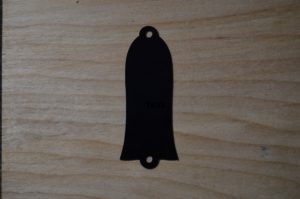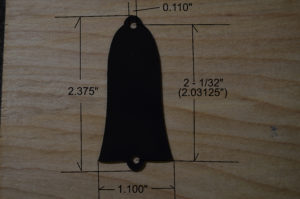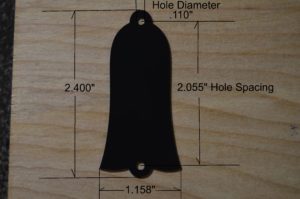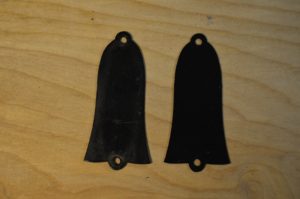From 1921 – 1963
(Click on the pictures for a larger view)
Gibson was the company that introduced the adjustable truss rod in 1921. Developed by Gibson employee Ted McHugh along with the adjustable height bridge. The adjustable truss rod allowed Gibson to make exceptionally fine, slim, comfortable playable necks (especially on their banjos) unlike some of the clubby, chubby necks that are popular today even though we have better truss rod technology today. Conversely, if a one-way, traditional truss rod is installed correctly and the fretting is done properly, nothing works better or makes a better sounding neck on a banjo, in my opinion.
The “Bell” covers, nicknamed for their obvious shape, that Gibson used to cover the truss rod’s adjustment access hole are what this article is about. The first bell covers used on banjos and mandolins in 1921 were small and held in place with 2 slot-head (standard) small wood screws. These were the same screws used to attach the tuning machines. In the early 1930s, the Phillips head screw were invented by Henry Phillips for the automotive industry but Gibson didn’t start using them in the wood screw form until about 1937. Remember… the one thing about Gibson that remained consistent throughout their history were their inconsistencies, so you absolutely will see slot head screws after 1937 in the years leading up to World War II when Gibson used anything and everything that was available to them old or new. These first generation truss rod covers were used until about 1937, somewhere around the same time as Phillips screws start showing up.
In 1921 the guitar truss rod covers were only slightly taller and wider at the base. These truss rod covers would reign until World War II was over. It would also be the only surviving truss rod cover after about 1937. This truss rod cover, even though a little clunky for use on smaller instruments, would then also be used on Gibson banjos and mandolins until the post World War II period beginning in 1948, as best I can tell. These two photos are of genuine Pre World War II celluloid truss rod covers.
From about 1944 (as best I can tell, but you know Gibson) until about 1963 most Gibson musical instruments (even banjos and mandolins) used an even wider and taller truss rod cover. These look really odd on banjos and mandolins to me. They aren’t nearly as sleek as their predecessors but this is the shape and size that ruled the late 1940s through the entire 1950’s and right up to the early 1960’s when things started changing very rapidly, and not for the better in most people’s opinion.
There were some metal truss rod covers used by Gibson during this time period and even a few rare sizes were used but these were the dominating “bell” covers. All 3 covers had 2 things in common: They were all 0.040″ thick and their screw holes were 0.110″ in diameter. As a professional luthier (a person who builds and repairs stringed musical instruments) I know how difficult these are to get your hands on when you need them. These go missing and get broken or the screw holes fail after the screws holding them are over-tightened. So called reproductions of these have been on and off the market for years but most of them look cartoonish to me. If I am doing a repair to a vintage piece I want something that duplicated the original, not just something that kinda looks like it if you stand back far enough.
Years ago we had access to some very good reproduction parts and I have an old, very large hoard of them here in my shop. The photos below are the dimensions of the original truss rod covers. From left to right you are looking at 1921-about 1937 banjo and mandolin. 1921 – the end of production during WWII guitar (and banjo and mandolin after about 1937) and on the right you have 1944-about 1963 truss rod covers for guitars banjos and mandolins.
The large hoard I have of each of these sizes look really good… they look good enough that if you don’t have a trained eye and a dial caliper you may not be able to tell the real thing from these faithful reproductions. The top row below are the originals and the bottom row in the photograph are the reproductions. The only difference I can see is that the reproductions are 0.005″ thinner than the originals… that’s pretty close!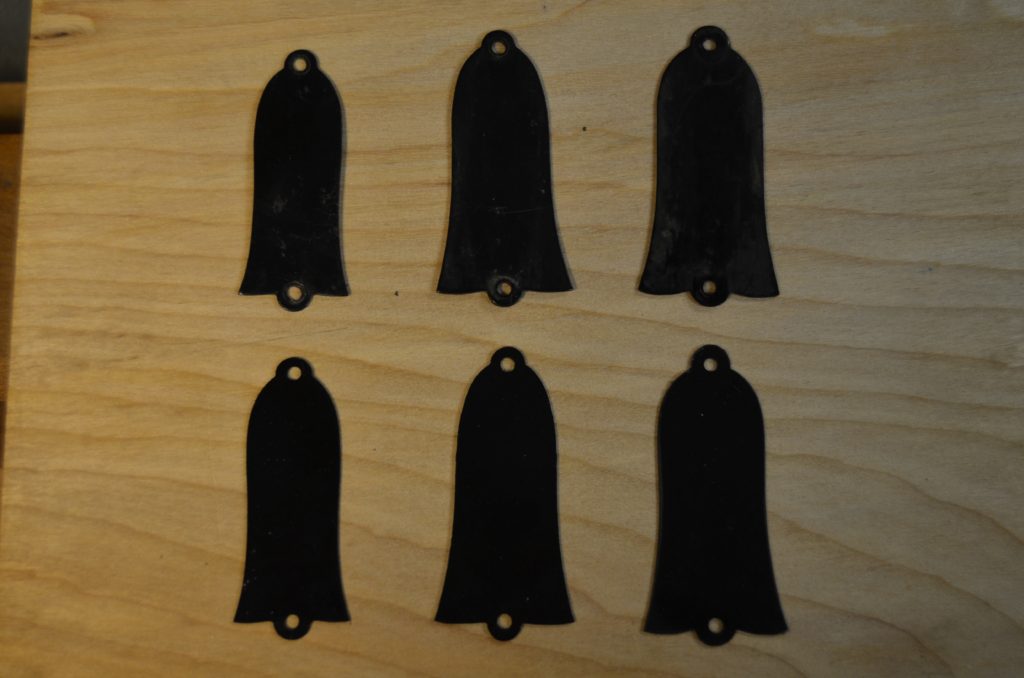 The photos below show the originals on the left and the reproductions on the right.
The photos below show the originals on the left and the reproductions on the right.
If you find yourself in need of some of these reproductions to replace a missing or damaged original truss rod cover I am willing to sell a few from the hundreds of each of these I have in my collection from all those years ago.
Thank you for visiting my website!
Richie Dotson
Acoustic Box LLC
Hopewell, Virginia

